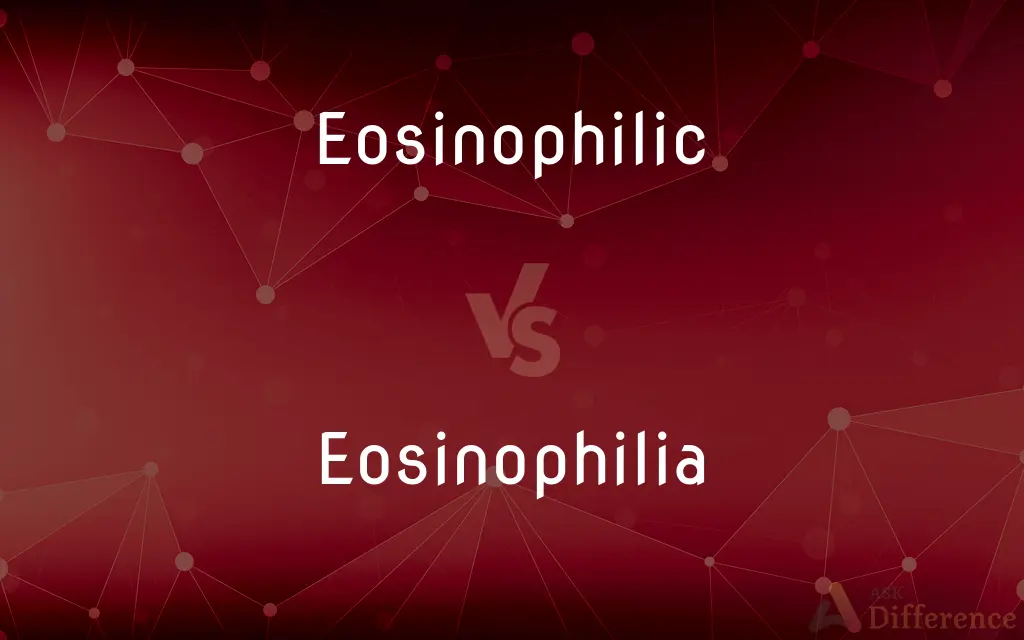Eosinophilic vs. Eosinophilia — What's the Difference?
Edited by Tayyaba Rehman — By Fiza Rafique — Updated on May 9, 2024
"Eosinophilic" describes cells, tissues, or conditions involving eosinophils, a type of white blood cell, while "eosinophilia" refers to an abnormally high count of eosinophils in the blood.

Difference Between Eosinophilic and Eosinophilia
Table of Contents
ADVERTISEMENT
Key Differences
"Eosinophilic" is an adjective describing any cell, tissue, or substance that shows a strong affinity for eosin, a red dye. "Eosinophilia" is a noun indicating an elevated level of eosinophils in the bloodstream, usually due to an allergic reaction or infection.
When talking about conditions, "eosinophilic" disorders involve an abnormal accumulation of eosinophils in tissues. On the other hand, "eosinophilia" is often used to diagnose underlying diseases that cause an increased number of these cells in the blood.
"Eosinophilic" infiltrates in tissues can cause inflammation and damage to organs. "Eosinophilia," however, can indicate systemic conditions such as allergies, parasitic infections, or autoimmune diseases.
"Eosinophilic" cells are typically identified in tissue samples under a microscope. Meanwhile, "eosinophilia" is identified through blood tests that quantify the percentage of eosinophils.
In medical research, "eosinophilic" diseases focus on localized or systemic tissue responses involving eosinophils, while "eosinophilia" is the measurement or state of high eosinophil levels.
ADVERTISEMENT
Comparison Chart
Part of Speech
Adjective
Noun
Definition
Related to eosinophils or eosin staining
High eosinophil count in blood
Diagnosis
Tissue examination
Blood test
Clinical Significance
Indicates eosinophil presence in tissues
Suggests allergic or parasitic conditions
Usage Context
Describes diseases or cells
Describes a clinical finding
Compare with Definitions
Eosinophilic
Pertaining to eosinophils.
The eosinophilic infiltrate was observed in the biopsy sample.
Eosinophilia
An increased level of eosinophils in blood.
The patient's blood test confirmed eosinophilia.
Eosinophilic
Staining readily with eosin.
The eosinophilic cytoplasm of the cell was clearly visible under the microscope.
Eosinophilia
Associated with allergic reactions.
Eosinophilia often develops in people with severe allergies.
Eosinophilic
Describing certain medical conditions.
Eosinophilic esophagitis is an inflammatory disease involving the esophagus.
Eosinophilia
Indicative of parasitic infections.
Eosinophilia can occur due to a parasitic infestation.
Eosinophilic
Related to allergic reactions.
Eosinophilic asthma is triggered by allergens.
Eosinophilia
Suggestive of autoimmune disorders.
The doctor considered eosinophilia as a symptom of the patient's autoimmune disease.
Eosinophilic
Exhibiting eosinophil infiltration.
The tissue sample showed signs of an eosinophilic response.
Eosinophilia
A hematological finding.
The lab results showed marked eosinophilia, requiring further investigation.
Eosinophilic
Eosinophilic (Greek suffix -phil-, meaning loves eosin) refers to the staining of certain tissues, cells, or organelles after they have been washed with eosin, a dye. Eosin is an acidic dye; thus, the structure being stained is basic and as a corollary, is acidophilic.
Eosinophilia
Eosinophilia is a condition in which the eosinophil count in the peripheral blood exceeds 5×108/L (500/μL). Hypereosinophilia is an elevation in an individual's circulating blood eosinophil count above 1.5 x 109/L (i.e.
Eosinophilic
Easily stained by eosin or other acid dyes. Used of a cell or cell structure.
Eosinophilia
An increase in the number of eosinophils in the blood.
Eosinophilic
Of or relating to eosinophils.
Eosinophilia
(medicine) The condition of having a high concentration of eosinophils (eosinophil granulocytes) in the blood.
Eosinophilic
(cytology) That is readily stained with eosin.
Eosinophilia
A symptom of allergic states; increased eosinophils in the blood
Eosinophilic
(medicine) Of, pertaining to an eosinophil or to eosinophilia.
Eosinophilic
Of or relating to eosinophil
Common Curiosities
Can "eosinophilic" and "eosinophilia" be used interchangeably?
No, "eosinophilic" describes cells or tissues while "eosinophilia" refers to high eosinophil levels.
What causes eosinophilia?
Allergies, parasitic infections, and autoimmune diseases are common causes.
Can eosinophilic conditions affect the entire body?
Yes, some disorders can cause systemic effects like eosinophilic granulomatosis.
Do all eosinophilic conditions lead to eosinophilia?
Not necessarily; some may have localized effects without raising blood eosinophil levels.
Is eosinophilia always harmful?
It may indicate an underlying issue, but in mild cases, it might not cause direct harm.
How is eosinophilia diagnosed?
Through a blood test that measures the percentage of eosinophils.
What are eosinophils?
White blood cells involved in immune responses, especially against parasites and allergens.
Are eosinophilic diseases curable?
Treatment varies depending on the cause but often focuses on reducing inflammation.
Is "eosinophilic" always linked to diseases?
No, it simply describes cells or tissues containing eosinophils or staining with eosin.
Can medications cause eosinophilia?
Yes, certain drugs can trigger an increase in eosinophil levels.
Can eosinophilia be a sign of cancer?
In rare cases, it can be associated with certain types of cancers like leukemia.
Is eosinophilia common?
It is relatively common in regions where parasitic infections are prevalent.
What specialist treats eosinophilic conditions?
Allergists, immunologists, and gastroenterologists often handle these disorders.
How is eosinophilic esophagitis treated?
With dietary changes, steroids, and medications to reduce inflammation.
Can children have eosinophilic diseases?
Yes, children can also develop eosinophilic esophagitis or other conditions.
Share Your Discovery

Previous Comparison
Unblinded vs. Blind
Next Comparison
Good vs. KnowledgeAuthor Spotlight
Written by
Fiza RafiqueFiza Rafique is a skilled content writer at AskDifference.com, where she meticulously refines and enhances written pieces. Drawing from her vast editorial expertise, Fiza ensures clarity, accuracy, and precision in every article. Passionate about language, she continually seeks to elevate the quality of content for readers worldwide.
Edited by
Tayyaba RehmanTayyaba Rehman is a distinguished writer, currently serving as a primary contributor to askdifference.com. As a researcher in semantics and etymology, Tayyaba's passion for the complexity of languages and their distinctions has found a perfect home on the platform. Tayyaba delves into the intricacies of language, distinguishing between commonly confused words and phrases, thereby providing clarity for readers worldwide.












































